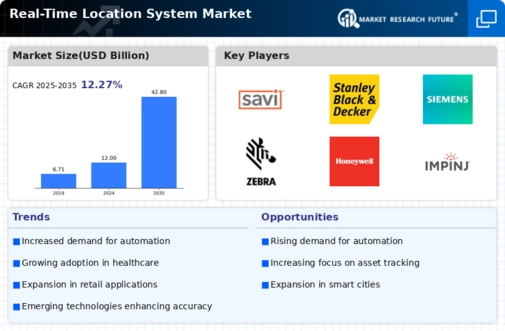Top Industry Leaders in the Real-Time Location System Market

Competitive Landscape of the Real-Time Location System (RTLS) Market
The Real-Time Location System (RTLS) market is experiencing explosive growth, fueled by increasing demand across various industries including healthcare, manufacturing, logistics, and retail. This rapidly evolving landscape presents both challenges and opportunities for established players and emerging companies. Here, we delve into the competitive landscape, analyzing key players, prevalent strategies, market share determinants, and recent investment trends.
Key Players:
- IBM corporation
- Zebra Technologies Corporation
- STANLEY corporation
- General Electric Company
- Siemens AG
- Airista Flow Inc.
- Sonitor Technologies Inc.
- RF Technologies Inc
- PINC Solutions
- IDENTEC Solutions
- Radiance
- CenTrak
- PLUS Location Systems USA
- TeleTracking Technologies Inc
Strategies Adopted:
- Product portfolio expansion: Leading players are continuously expanding their product portfolios, offering various RTLS technologies like Wi-Fi, RFID, Bluetooth, UWB, and GPS. This caters to diverse user needs and allows them to cater to various industries.
- Strategic partnerships: Companies are forging strategic partnerships to expand their reach, tap into new markets, and access complementary technologies. This allows them to leverage expertise and resources, creating a stronger market presence.
- Technology innovation: Investments in R&D are crucial for staying ahead of the curve. Companies are actively exploring emerging technologies like UWB and artificial intelligence (AI) to enhance accuracy, functionality, and insights derived from location data.
- Focus on vertical markets: Recognizing the diverse needs of different industries, companies are tailoring their solutions and marketing strategies to address specific industry verticals. This allows them to gain a deeper understanding of user needs and offer customized solutions.
Factors for Market Share Analysis:
- Technology: The type of RTLS technology employed (Wi-Fi, RFID, Bluetooth, UWB, etc.) significantly influences market share, with each technology catering to distinct accuracy and range requirements.
- Industry focus: Companies focusing on specific industries like healthcare or manufacturing often hold a stronger market share within those sectors due to their specialized expertise and tailored solutions.
- Geographic reach: Global players with a strong presence across various regions hold a larger market share than companies focused on specific regions.
- Customer base: The number and size of prominent customers influence market share, with large enterprise deployments contributing significantly to market dominance.
- Brand reputation: Established players with a strong brand reputation and proven track record often command a larger share of the market due to trust and credibility.
New and Emerging Companies:
Several new and emerging companies are poised to disrupt the RTLS market with innovative technologies and disruptive business models. These companies often focus on specific niches or utilize cutting-edge technologies like UWB, offering unique value propositions to attract customers. Some notable examples include:
- Chirp: This company offers a unique RTLS solution based on chirping sound waves, providing high accuracy and scalability with minimal infrastructure requirements.
- HERE Technologies: This company leverages its expertise in location-based services to offer comprehensive RTLS solutions, including mapping, routing, and data analytics.
- Nodle: This company utilizes a decentralized network of smartphones to create a low-cost and extensive RTLS platform, ideal for large-scale deployments.
Current Investment Trends:
The RTLS market is witnessing a surge in investments from venture capitalists and private equity firms. This indicates growing investor confidence in the market's potential, driven by the increasing adoption of RTLS solutions across various industries. Recent investment trends include:
- Focus on emerging technologies: Investments in companies developing UWB-based RTLS solutions are increasing due to the technology's superior accuracy and scalability.
- Industry-specific solutions: Investors are recognizing the potential of specialized RTLS solutions tailored to specific industries like healthcare or manufacturing, leading to increased funding for companies catering to these sectors.
- Cloud-based solutions: Investments in cloud-based RTLS platforms are rising due to their ease of deployment, scalability, and data analysis capabilities.
- Open-source platforms: Open-source RTLS platforms are gaining traction as they offer lower costs and greater flexibility for developers and users.
Latest Company Updates:
The world leaders in lighting systems, Signify, and Kontakt.io, a pioneer in inpatient journey analytics, have announced a partnership to integrate BLE-powered indoor IoT and location services into Signify's connected lighting solutions in 2023. This partnership will allow healthcare providers to seamlessly and affordably future-proof building infrastructure, including both new construction and retrofits, and improve the experience for both staff and patients.
Leading real-time location system (RTLS) supplier Inpixon® announced today, 2023, the integration of ChatGPT, a generative AI, into Inpixon's RTLS solution. With the help of this creative integration, Inpixon's RTLS can now do more, including quick insights supported by AI and engaging conversations in a conversational format. This revolutionary advancement is particularly advantageous for production and logistics operations managers.
In 2022, Honeywell unveiled Honeywell Safety Watch, an RTLS (real-time location system) designed to increase worker productivity and promote safety and security. The Safety Watch provides businesses with actionable data about their employees and assets to assist them fulfil the demands of contemporary industrial operations, thereby promoting continuous operational improvement.

